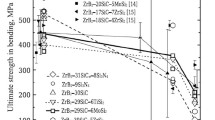Compaction kinetics, structurization, and mechanical characteristics of ceramics based on zirconium boride during the combined addition of sintering activating carbon additives, tungsten boride, and zirconium and tungsten silicides into the system are investigated. It is shown that the efficient additives for ZrB2 ceramics are tungsten silicide and boride, which allow not only reducing the sintering temperature and activating the ceramic compaction, but also provide the maximum strength of the samples. The shrinkage of activator-free ZrB2 occurs in the restructuring of boride that sinters with the formation of an azimuth texture. It is established that these processes do not occur in the ceramics sintered with activators. When such processes are developing, the sintering occurs under the conditions of intensive grain-boundary phase interactions. The mechanical characteristics are studied mainly by the indentation method with the determination of a certain number of ceramic strength characteristics. The differences in the characteristics of ceramics produced by hot pressing in vacuum and by hot pressing in the CO–CO2 atmosphere are studied. It is established that the grain-boundary strength of forming materials and their defective state show the greatest differences. The data obtained allow optimizing the production, composition, and structure of ceramics to ensure the necessary mechanical characteristics (compressive strength, tensile strength, bending strength, hardness, and fracture toughness).









Similar content being viewed by others
References
A. Belossi, S. Guicciardi, V. Medri, et al., “Processing and Characteristics of Ultra-Refractory Composites Based on Zr- and Hf-Borides: State of the Art and Perspectives,” in: Boron Rich Solids, N. Orlovskaya and M. Lugovy (eds.), Springer Publ., Netherland, Dordrecht (2010), pp. 147–160.
F. Monteverde, “The addition of SiC particles into a MoSi2-doped ZrB2 matrix. The effects on densification, microstructure and thermo-physical characteristics,” Mat. Chem. Phys., 113, Nos. 1–2, 626–633 (2009).
J. Zon, G.-J. Zhang, Y.-M. Kan, P.-L. Wang, “Pressure less densification of ZrB2–SiC composites with vanadium carbide,” Scr. Met., 59, 309–312 (2008).
B. A. Galanov and O. N. Grigoryev, “The analytical model of indentation of brittle materials,” Elektron. Mikroskop. Proch. Mater., No. 13, 4–42 (2006).
B. A. Galanov, O. N. Grigoryev, and E. G. Trunova, “The statistical characteristics of ceramics contact strength,” Elektron. Mikroskop. Proch. Mater., No. 11, 125–135 (2001).
O. N. Grigoryev, B. A. Galanov, V. A. Kotenko, et al., “Contact strength and fracture toughness of brittle materials,” Metallofiz. Novey. Technol., No. 8, 1001–1018 (2005).
O. N. Grigoryev, V. B. Vinokurov, L. I. Klimenko, et al., “Contact Interaction in the ZrB2–Cr3C2 System,” in: 4-th International Conference “High Mat. Tech.” (October 7–11, 2013, Kyiv), Kyiv (2013), p. 270.
O. N. Grigoriev, B. A. Galanov, V. A. Lavrenko, et al., “Oxidation of ZnB2–SiC–ZrSi2 ceramics in oxygen,” J. Eur. Ceram. Soc., 30, No. 11, 2397–2405 (2010).
O. N. Grigoriev, B. A. Galanov, V. A. Kotenko, et al., “Mechanical characteristics of ZnB2–SiC(ZrSi2) ceramics,” J. Eur. Ceram. Soc., 30, No. 11, 2173–2181 (2010).
G. A. Meyerson and A. E. Gorbunov, “Activated sintering of zirconium boride,” Izv. AN SSSR. Neorgan. Mater., 4, No. 3, 320–324 (1967).
D. M. March, “Plastic flow in glass,” Proc. Royal Soc. Series A, Math. Phys. Sci., 279, No. 1378, 420–435 (1964).
I. N. Bogachev, A. A. Vainshtein, and S. D. Volkov, Introduction to Statistical Physical Metallurgy [in Russian], Metallurgiya, Moscow (1972), p. 216.
K. Niihara, R. Morena, and D. P. H. Hasselman, “Evaluation of K Ic of brittle solids by the indentation method with low crack-to-indent rations,” J. Mat. Sci. Let., 1, No. 1, 13–16 (1982).
Author information
Authors and Affiliations
Corresponding author
Additional information
Translated from Poroshkovaya Metallurgiya, Vol. 55, Nos. 11–12 (512), pp. 54–70, 2016.
Rights and permissions
About this article
Cite this article
Grigoriev, O.N., Vinokurov, V.B., Mosina, T.V. et al. Kinetics of Shrinkage, Structurization, and the Mechanical Characteristics of Zirconium Boride Sintered in the Presence of Activating Additives. Powder Metall Met Ceram 55, 676–688 (2017). https://doi.org/10.1007/s11106-017-9855-y
Received:
Published:
Issue Date:
DOI: https://doi.org/10.1007/s11106-017-9855-y




